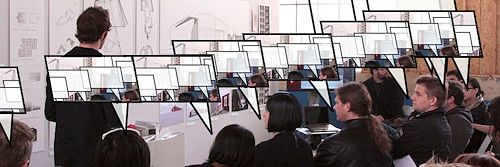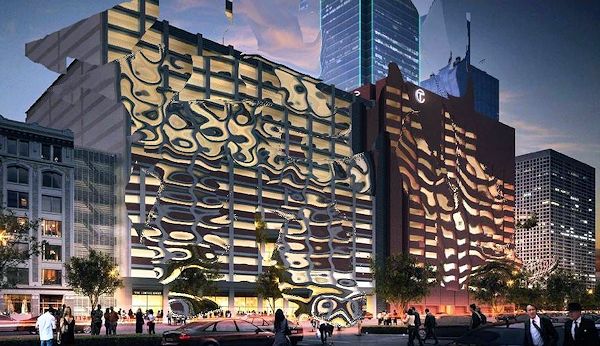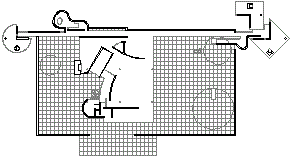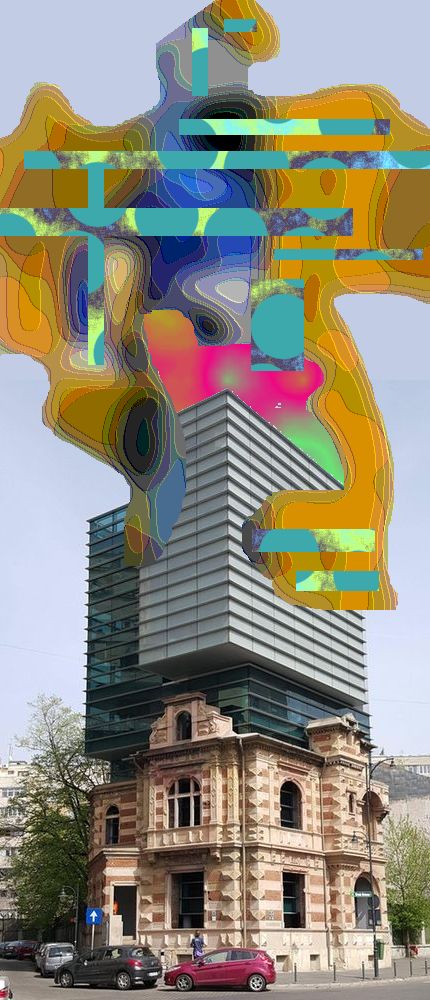2015.03.22 18:30
Pondering the cultural value of Frank Gehry's Winton Guest House
And I forgot to mention Venturi and Rauch's Brant House, Bermuda (1975).
2015.03.22 20:44
Pondering the cultural value of Frank Gehry's Winton Guest House
Not just in plan. Kahn's, Stirling/Wilford's and Venturi/Rauch's designs are also studied volumes. The verticality of Kahn's design in particular precurses Gehry's. And I certainly don't buy that Gehry was somehow uninterested in or unaware of what other architecture was being designed and built at the time or just prior--let's just be realistic about that.
The Cooper & Pratt House was never built. It was for an in-office competition for a spec house. The 'developer'/judge picked a design that looked just like a farmhouse. Within a half year the designer of the 'farmhouse' was fired, and his design was eventually handed over to me. After a day of looking over the design, I had to ask my boss, Roger Pratt, for 10 minutes of his time so I could show him what I found, which were a myriad of functional and programmatic errors and mis-designs. Roger agreed and said, "Well, just fix it." A couple days later I showed Roger what I had done, which turned out to be a pretty decent redesign, and he took his time looking over the drawings with this odd look on his face, and then he looked directly in my face and asked, "How did you do that?"
2015.03.22 21:35
Pondering the cultural value of Frank Gehry's Winton Guest House
Let's hope so. The whole point of looking at precedents is to learn from and be inspired by them, and subsequently execute a design that adds something more to them.
2015.03.23 14:50
Why do all hipsters look the SAME?
Orhan, in what sense do you see Vertical farms, Poche, Blobs, Hedonistic urbanism, Parametric buildings, New Urbanism, Old Urbanism, etc, etc, as trends that evolve into mainstream? I can see New Urbanism as having moved much more into the category of mainstream, but the rest look like trends that may last a year of two and then forgotten and/or replaced by some new trend. (The latest issue of Log (33) exemplifies a new trend replacing an older trend.)
Rather than following the 'evolution' of trends, it might be more valuable/realistic to look for and call out the mutations within the design continuum, for it seems that those designs/buildings that are somehow unexpected and/or just different enough from the trends/norms are what produce more substantial effects on the further developing of the design continuum.
2015.04.23 10:36
Archinect's critical round-up for the new Renzo Piano-designed Whitney Museum
davvid, assuming you're in NYC, do you have any thoughts on how the New Whitney Museum compares with the New Museum? I'm just curious, as I only know these buildings from pictures. For example, is the New Whitney much larger than the New Museum? (--if I were to just guess, the New Whitney seems about double in size.) Does the New Whitney lack the "aesthetic refinement" of the New Museum? Since both these new museums are 'stacked' (Koolhaas's "culture of congestion"?), I imagine there's something to learn from a compare/contrast.
| |
2015.04.23 13:04
Archinect's critical round-up for the new Renzo Piano-designed Whitney Museum
davvid, thanks. First off, I have yet to own a mobile phone, so I've never used Instagram.
Aha, the New Whitney is almost 3.5 times the size of the New Museum--the New Whitney actually does have the look of a behemoth, doesn't it? Jason already mentioned the New Whitney's welcome interaction with the city, and the notion of windows and balconies/outdoor space on every level certainly reinforces that. Makes me wonder if 'stacked' public institutions of the future will continue to take advantage of higher-up inside-outside opportunities.
Yesterday I was thinking about another compare/contrast of the New Whitney and the Philadelphia Museum of Art. The PMA is about 90 years old now, and it too is at the terminus of an urban greenway--the Benjamin Franklin Parkway. The whole scheme was part of what was called the "City Beautiful Movement"--very 'Beaux Arts' urbanism in conception and execution. Now, in NYC almost a century later, there's the New Whitney at the terminus of another new urban greenway--the Highline. Some might (want to) say this new scheme is all about a "City Ugly Movement," and it may well be not all that "overly attractive", but it seems to be at least a more mature type of urbanism. Donna earlier mentioned the 'ad hoc-ness' of the New Whitney design, and the same may be said about the approach of the urbanism--more using what you have than starting completely over to produce some idealized image. Maybe the "City Bricolage Movement."
Sometime around 2002.11.10 NYTimes architecture critic Herbert Muschamp wrote:
"Elizabeth Diller and Ricardo Scofidio have defined a new building type for the contemporary city: the urban viewing platform. Invention of this caliber doesn't turn up every day. Diller and Scofidio could spend the rest of their careers reworking this one idea over and over again and not be judged harshly for repeating themselves. The basic concept is that good, and its potential applications are various. Many cities will want to try out variations on the theme. But Boston will receive the first authentic edition in 2004, when the city's Institute of Contemporary Art is expected to open its doors."
I went on to criticize this with:
The "urban viewing platform" is NOT a new invention created by Diller and Scofidio. Every time I visit the Philadelphia Museum of Art I also visit a quite remarkable "urban viewing platform."
Anyway, it's now interesting, and indeed fortunate, that the New Whitney Museum has a relative abundance of art viewing platforms and "urban viewing platforms."
2015.04.27 11:09
what is 'beauty' in Architecture?
"Cultures, he argued, need the challenge of new forms if they are not to settle into complacency or, worse, terror.
His target here is what he calls 'realism'. Realism, he claims, reaffirms the illusion that we are able to seize hold of reality, truth, the way things "really" are.
Realism, Lyotard argues, protects us from doubt. It offers us a picture of the world that we seem to know, and in the process confirms our own status as knowing subjects by reaffirming that picture as true. Things are, humans are, and, above all, we are just as we have always supposed.
Postmodernity, in Lyotard's account, specifies a different literary and artistic mode rather than a particular period. Duchamp's challenge to realism is intelligible as postmodern. 'You want realism?' Richard Mutt's urinal seemed to ask. 'I'll give you reality itself, a readymade urinal, exactly the kind you see every day'. Er, that is, the kind men see every day. Well, Western men, anyway. Reality itself, when you come to think of it, is also culturally relative."
--Catherine Belsey
| |
2015.04.30 12:22
‘Architecture is now a tool of capital, complicit in a purpose antithetical to its social mission’
Public funded housing throughout the 20th century provided a multitude of big commissions for architects, often at times when big architecture commissions were difficult to come by.
It's not a stretch then to see architects advocating public housing as a means for there being more architectural commissions available, as well as for the greater good.
2015.05.07 10:15
'The Final Review: Negaters Gonna Negate'

"In order to become limitless, you have to drink the blood of some guy you just shot. It's true. I saw it in some movie."
2015.05.08 10:40
Architecture Critic Mark Lamster: "We systemically encourage bad building."
The real problem is that new development isn't junky enough.

"Junky is so uniquely 21st century. I love all of it!"
2015.05.08 12:20
Architecture Critic Mark Lamster: "We systemically encourage bad building."
"Oh yes, 'Junky Architecture' is indeed uniquely 21st century, but aren't you also glad to see how 22nd century architecture is now even "Junkier"? I mean, I'm like ecstatic over it!"
And if "silly memes" killed the "Folk Art demo opposition," then the "Folk Art demo opposition" must have been a featherweight and the "silly memes" a heavyweight.
2015.05.08 12:42
Architecture Critic Mark Lamster: "We systemically encourage bad building."
Don't just embrace the junk, make it junkier!
| |
2015.05.23 12:32
Construction of Steven Holl-designed Queens Library is underway
I wouldn't put Holl's designs so much ahead of all other present architectural design. Looking at the body of work from the 21st century so far, the designs are very much within the overall milieu of 21st century design, sometimes original tangents, sometimes somewhat reactive, yet always carefully considerate of the Zeitgeist in general.
2015.05.26 08:47
New photos of E. Fay Jones' Thorncrown Chapel unveiled to mark 35th anniversary
Is there any actual evidence that "imitating Frank Lloyd Wright is invariably not productive at all?" I understand the implication of such a supposition, i.e., to be productive you must progress, but is there really any evidence that imitating FLW leads directly to non-progress?
2015.05.26 09:46
New photos of E. Fay Jones' Thorncrown Chapel unveiled to mark 35th anniversary
...you put forth a whole range of issues that are loose, if not also mostly unresolved.
"If you believe...", so it depends on a system of (personal) belief?
"most definitely", really? there should then be definite proof.
Not "an evidence question so much as a philosophical question, a question about aesthetics. As I see it...", so it does depend on a system of personal belief.
So copy and imitate are the same thing?
Why exactly are the works of the Taliesin Associated Architects not worth the time of day? How has that been proven to be true. Have you given them any time at all?
"...there is a considerable difference between copying Wright and Wright's influence" Is this the same considerable difference between imitating Wright and Wright's influence? Again, copying and imitating are the same thing?
So imitating the generic is just fine, but imitating the idiosyncratic is not just fine?
In today's world where in some instances it is possible for a copy to be exactly the same as the original, the whole notion of copy needs new "philosophical" definitions. The whole notion of cloning, is a real indication of exactly that.
Imitation, on the other hand, has always been a process that involves individual creativity in both assimilation and execution. To an imitator, the original and influence are virtually the same thing. Imitators get very creative with the original/influence.
2015.05.26 12:35
New photos of E. Fay Jones' Thorncrown Chapel unveiled to mark 35th anniversary
...the Massaro House isn't even a copy, it's an attempt to produce an original.
...the present Barcelona Pavilion is an exact copy of the original Barcelona Pavilion. If the present Barcelona Pavilion were exact to your specifications above, i.e., the exact same materials as the original, then it wouldn't be a copy, it would be the original. The galleries of the present Barnes Foundation are an exact copy of the original galleries of the Barnes Foundation.
I'm more concerned over recognition of the distinction between copy and imitation. And I'm concerned over DWL's use of definitive language were really there are no definitives.
Here's an example of architectural design via (digital data) copying:

There is no imitation involved at all.
| |
2016.04.11 13:04
architecture gone wrong

2116.04.11, hopefully.
|